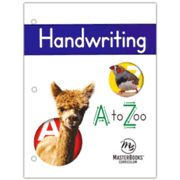Handwriting A to Zoo teaches children how to print lowercase letters, uppercase letters, and numbers in a traditional, ball-and-stick style. At the end of the course, students are asked to trace and copy Bible verses in complete sentences, so the program takes children from writing individual letters to writing words and then sentences.
This 455-page book includes both instructional material and student worksheets. The course’s 36 lessons are arranged as daily lessons that each take 20 to 30 minutes. This is more time than is usually required for handwriting courses, because, in addition to letter formation, tracing, copying, and printing their own words, Handwriting A to Zoo includes brief instruction about the two animals highlighted each week, a little geography related to the animals, Christian faith connections, warm-up activities to build hand strength and motor skills, letter and number identification, maze puzzles, coloring, and arts and crafts activities related to the theme or letter being taught.
The last five lessons, labeled Super Skills, have students trace and copy Bible verses of one or two sentences. All activities in these five lessons are Bible related. For instance, page 354 says, “God is our helper. Do you help other people or a pet? Write their name. Then draw a picture of the helping task.” Below this is a line on which students write the name and box for their drawing. Faith-based content appears throughout the course as scripture verses parents read aloud, as mentions of God in the information about animals, and in some of the words students copy and write in Lesson 8 and beyond (e.g., Elijah, grace, and Savior).
Students write with a pencil in every lesson, and they frequently use crayons, colored markers, colored pencils, clear tape, play dough, and scissors. Other resources, such as a glue stick, cotton balls, watercolors, school glue, finger paints, toothpicks, and dry rice, are among those on the Supply List for individual lessons (shown on pages 9 and 10). Parents need to gather the extra supplies needed some weeks, but otherwise, the course can be used in an open-and-go fashion.
The pages from 381 to the end of the book are resource pages. Tear-out pages will be used for arts and crafts activities in some of the lessons. Optional reviews can be used every three weeks, beginning after the first six weeks, and there are optional pre- and post-assessments. Two rubrics are provided to help parents evaluate student work. The Handwriting Rubric is intended for use with the optional reviews but might be used for other handwriting done in the course. The Activities Rubric is more general and can be applied to most other activities. An answer key provides answers for some exercises, and this section concludes with an “All-About-Me” page and a Certificate of Completion.
The book can be purchased as a printed book or a PDF. Parents can print pages for their immediate family members. The pages are printed in color and use large fonts for the material students read, trace, or copy. If you don’t have access to inexpensive color printing, you might find the printed book a better choice.
Summary
Handwriting A to Zoo makes handwriting more fun for children to learn by using many different types of activities while simultaneously strengthening skills applicable to other academic areas.











